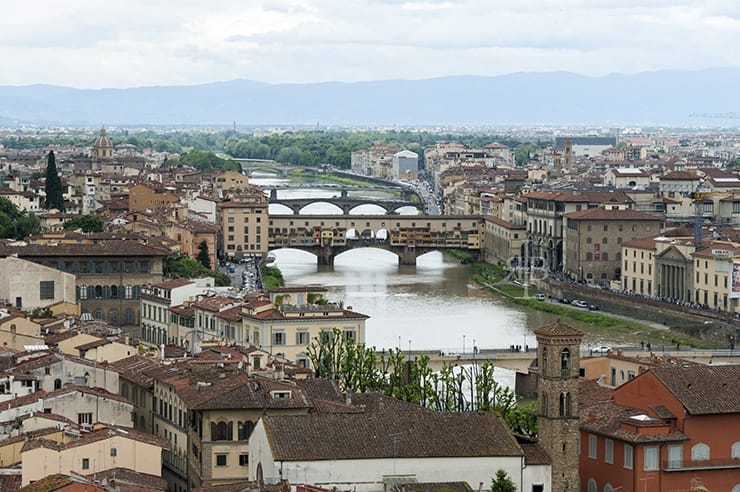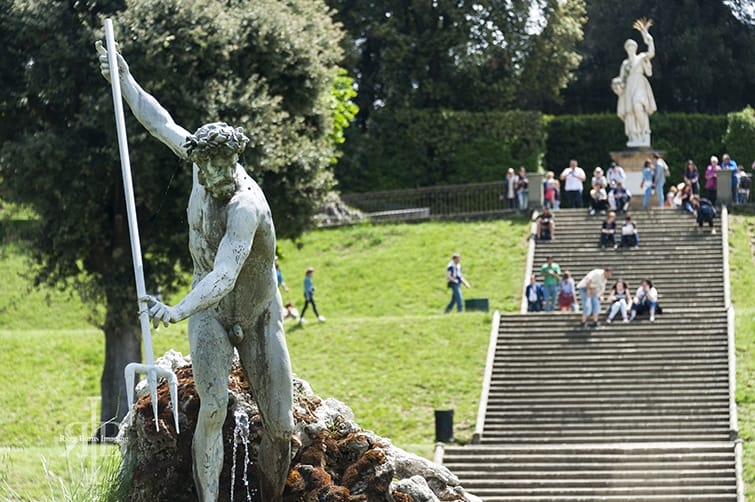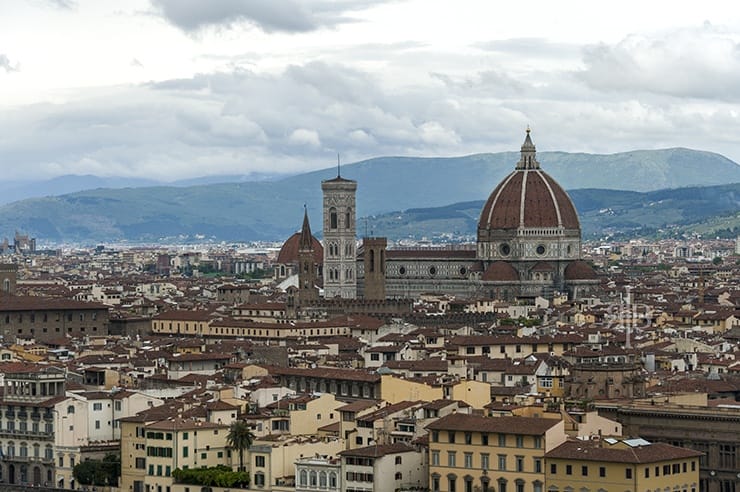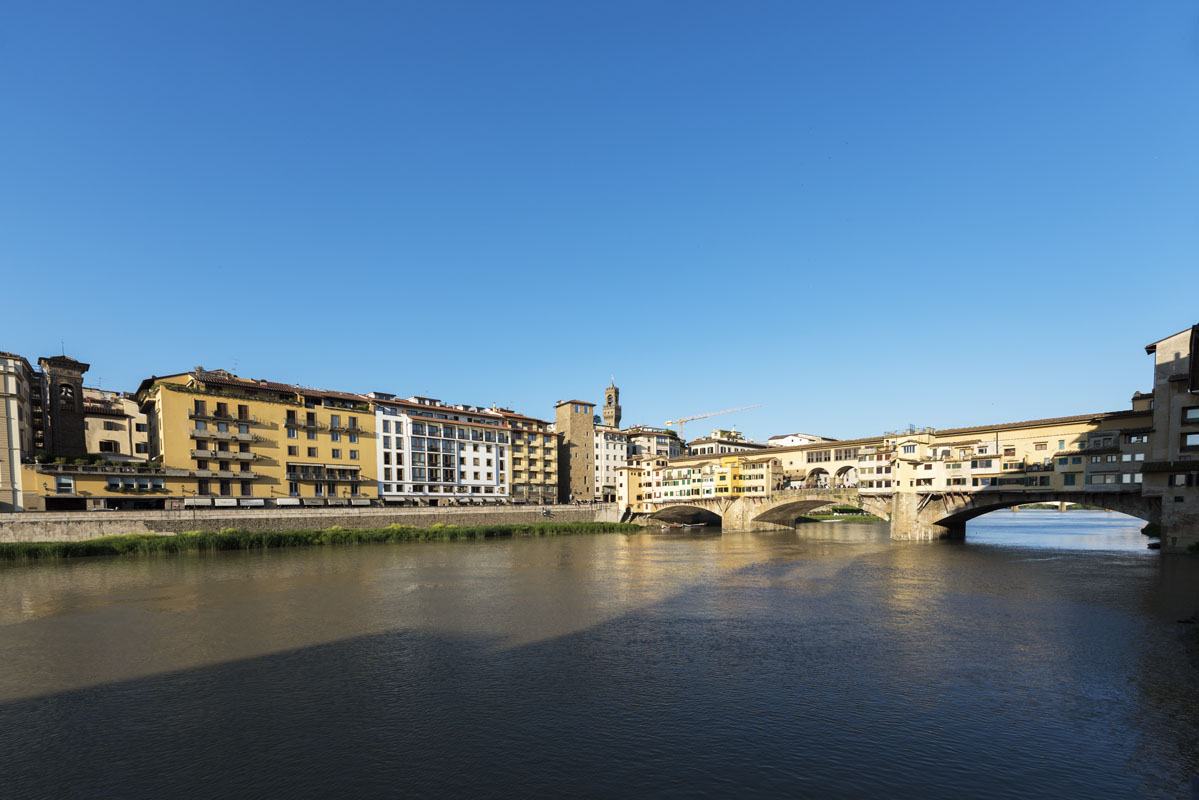Are you visiting Florence for the first time? This 2 days in Florence itinerary covers all the main sights, making it ideal for first-time visitors. Includes practical info to help you make the most of your time in Florence!
Experience the best of Florence on these tours! Our favourite tour provider is GetYourGuide, offering a variety of activities, flexible booking, and 24/7 support!
- Florence: Cathedral, Duomo Museum, and Baptistery Tour – see the best of the Duomo complex
- Florence: Uffizi Gallery Small Group Tour – see unforgettable Renaissance art with a specialized guide
- Florence: Uffizi Gallery, David & Accademia Small Group Tour – two of Florence’s big-ticket sights!
- Florence: Pasta and Tiramisu Cooking Class with Wine – learn to cook amazing Tuscan food!
- Florence: Palazzo Vecchio Guided Tour – learn all the mysteries of this fascinating place 🙂
If you’re visiting Italy for the first time, I’m sure your wishlist will include Florence. After all, it’s probably the place that best encompasses people’s “Italian dream” – sunshine, narrow streets, delicious food, and so much art and beauty you can’t possibly see it all.
For this reason, it’s no surprise that Florence is visited by hordes of tourists every year. Everyone wants a taste of the Dolce Vita and Renaissance beauty the city is well known for, and if you visit with no adequate planning, your Italian dream may soon turn into a nightmare, as you stand in endless lines under the sun.
We’ve put together this 2 days in Florence itinerary to help first-time visitors have a great time in the city. In just two days, you’ll see all the main sights – the statue of David, the Uffizi Gallery, the marvellous Duomo complex, Palazzo Vecchio, Palazzo Pitti and more.
The itinerary is not crazy fast-paced, with everything scheduled down to 15-minute intervals. You’re on holiday, not going to work – there should always be some time for spontaneity!
Before diving straight into this Florence in 2 days itinerary, let’s look at some practical info!
Florence Practical Info
How Many Days in Florence?
Two days in Florence are the bare minimum to see the sights without rushing around. The city centre is compact and walkable, and all sights are between 10 and 15 minutes walk from one another, with the exception of Piazzale Michelangelo which is a little further away.
If you have only one day, you can still see most of the main sights, but you’ll literally be jumping from one place to the other. However, if this is all you can spare, we’ve thought of you – here’s our one day in Florence itinerary.
3 days in Florence are an even better option if you’re planning to take a day trip, still giving you two full days to explore the city.
In any case, you should definitely book tickets ahead of time. – check out the links below!
- UFFIZI: Skip the Line Uffizi Gallery Entrance Tickets
- DAVID: Accademia Gallery Reserved Ticket
- CATHEDRAL + DOME: Florence Duomo: Entrance to Cathedral and Brunelleschi Dome
- CATHEDRAL (no climbing): Florence Duomo Cathedral Guided Tour
- PITTI PALACE: Pitti Palace Entrance Ticket
- BOBOLI GARDENS: Boboli Gardens Entrance Ticket
Best Time to Visit Florence
With the exception of the hot summer months, Florence is a year-round destination. Spring is ideal if you want to see the flowers in Boboli Gardens, but it’s really busy. Temperatures are mild in spring and autumn, while winter is the quietest time of the year, and the best time to get hotel deals.
However, please bear in mind that Florence is NEVER tourist-free. Months like November, January, and February are the best times to avoid the crowds – but the days will be short, and the weather might get miserable.
Summer is the only time of the year that should definitely be avoided. The city is packed with tourists from all over the world, summer students, day trippers and cruise travellers. There are queues EVERYWHERE, locals are at the end of their wits, and many of them won’t even visit the centre altogether. And did I mention it’s hot? Florence is always one of the hottest cities in Italy!

How to Get to Florence
Florence is placed along Italy’s excellent high-speed railway network. The city is one of the intermediate stops on the Milan-Rome and Venice-Rome lines, continuing all the way to Naples and Southern Italy. Thanks to these train lines, travelling around Italy by train is really easy and hassle-free. Here are travel times between Florence and main cities around Italy:
- Milan: 2 hours
- Venice: 2.30 hours
- Bologna: 1 hour
- Rome: 2/2.30 hours
Many Tuscan cities like Lucca, Pisa and Siena can be reached by regional train from Florence.
How to Get Around Florence
This 2 days in Florence itinerary can be covered on foot. All sights are just a few minutes walk from one another.
The only place that requires uphill walking to get to is Piazzale Michelangelo. It takes about 20 minutes to walk there from Oltrarno, or else you can opt for a bus or taxi. Just don’t try to take your car into Florence and drive around if you want to preserve your mental sanity!
Two Days in Florence – Day 1
Morning – Galleria dell’Accademia

Start the day by visiting one of the most famous statues by Michelangelo, David. The statue of the naked shepherd is situated in the Tribune Hall in the Gallery of the Academy of Florence and dates back to the early 1500s. Above it, the skylight in the dome shines natural light onto David, symbolizing a natural halo.
Around it, there are other interesting sculptures by different artists that shared styles and beliefs with Michelangelo.
There are several other halls in the museum where you can see a wealth of sculptures and paintings from important artists. Besides David and the Slaves by Michelangelo, the most noteworthy are the Coronation of the Virgin by Jacopo Di Cione which is a radiant golden painting, originally part of the altarpiece of the San Pier Maggiore church in Florence, the painting of the Tree of Life by Pacino di Buonaguida, showcasing different happenings in the bible hanging like ornaments from a crucified Christ symbolizing the tree of life, and the marble statue Rape of the Sabines by Jean de Boulogne.
Besides, you can see a large number of musical instruments, representing the day-to-day musical habits of the Medicean court, and generally an extensive collection of statues and paintings from the 13th and 14th centuries.
Check out our full Accademia Gallery guide and book your entrance ticket here!
Palazzo Vecchio
After David, it’s time to head to Piazza della Signoria, one of the most beautiful (and busiest) in Florence. The most notable building is Palazzo Vecchio (Old Palace), home to the Town Hall, the Cinquecento Hall, and Museo dei Ragazzi. It used to be the seat of the political power in Florence.
Its opulence can be seen already at the entrance where you will be met by replica statues of Hercules and Cacus, David by Michelangelo, and a sculpture of Adam and Eve.
Other masterpieces you can take in there are the newly renovated Fountain of Neptune, Loggia del Lanzi, and an equestrian statue of the second Duke of Florence, Cosimo I.
Palazzo della Signoria is one of the best examples of Florentine Renaissance palaces and has a tower looming 95 meters high above the city. The Arnolfo Tower offers 360 views of Florence and is well worth the climb.
Another of the top attractions in the palace is the Cinquecento Hall, which is Florence’s largest room at 54 meters long and 22 meters wide.
The palace hides a series of hidden corridors that the Medici built so that they had a way to escape enemy attacks and a place to hide away valuables. I won’t reveal anything else – book the secret Palazzo Vecchio tour (including the secret passages) to know more!
- Walking time from Galleria dell’Accademia: 15 minutes
Afternoon – Lunch at I Fratellini
Palazzo Vecchio is right next to Via dei Neri and Via dei Cimatori, home to many of Florence’s famous panini shops, perfect for a quick lunch stop. Skip the queues at L’Antico Vinaio and opt for I Fratellini just opposite – their options are all delicious, personally I love anything with finocchiona (fennel salami).
Palazzo Pitti
From Piazza della Signoria, walk across the Arno until you reach Palazzo Pitti. This massive building was built in 1446 as the residence of the Pitti Family. However, they were too ambitious with their wealth when they built the palace and the Medici Family took over the residence when the Pitti Family went bankrupt.
The Medici expanded and improved the palace significantly. Later, when Florence was the capital of Italy from 1865 to 1871, it became the residence of the Italian kings.
Inside, you find important art pieces hanging on the walls of the Galleria Palatina (Palatine Gallery). The majority of these paintings were put up by the Medicis, including colorful frescoes on the ceilings, and the gallery is now recognized alongside the Uffizi in artistic importance.
Other parts of the lavish palace include the Royal Apartments, the Gallery of Modern Art, and the Medici Treasury. Book your entrance ticket to Pitti Palace here!
- Walking time from Piazza della Signoria: 10 minutes
Giardino di Boboli

Florence’s largest garden, the Boboli Garden was designed by Filippo Brunelleschi, the architect of the famous Dome, as the Pitti Palace’s garden in 1457. Yet it was improved and expanded over 400 years after the Medici family bought the villa and later the Lorrain family took over.
You will understand the opulence of these families as you walk through the manicured gardens, in the shade of old oak trees, past ponds, rose gardens, detailed fountains, and the many Roman and Renaissance statues. It is still today the largest and most sought-after green space in Florence.
Among the most noteworthy attractions in the park, you find the amphitheater where multiple Roman statues are raised together with an obelisk that was brought in from Luxor in Egypt in the late 18th century.
There is also the Rococo Kaffeehouse, Neptune’s Fountain and walls by Michelangelo surrounding Giardino del Cavaliere, and the Buontalenti Grotto, also known as Grotta Grande (Big Grotto.) In the third of the 3 sections of the grotto, you can see the famous Bathing Venus by Giambologna.
Several buildings in the park, house important museums like the Museum of Costume and Fashion, and the Porcelain Museum.
Boboli Garden is VERY BUSY, especially in summer. Make sure you book your entrance tickets ahead of time – here’s our article with 6 ways to book Boboli Gardens tickets!
Evening – Piazzale Michelangelo

Piazzale Michelangelo is the most famous viewpoint in Florence and offers sweeping views of the city. Situated on a hill in the Oltrarno district in the south of the historical center, it was built in the 19th century as a memorial site for Michelangelo. On the square, there are several replicas of the artist’s sculptures, like David and the four statues that stand on Lorenzo and Giuliano de Medici’s tomb.
The original plans for the memorial site included a museum with replicas of the rest of Michelangelo’s statues. But the vision of architect Giuseppe Poggi did not get any further than the building of the loggia. Today, it houses one of the restaurants on Piazzale Michelangelo.
If you manage to time your visit for sunset, you are up for a treat as the sun reflects in the Arno River and on the rooftops of Florence’s skyline. From this viewpoint, you can see the Duomo and other towers and churches rising above the terracotta rooftops.
- Walking time from Giardino di Boboli: 20 minutes / or take bus n 12 from Porta Romana
Dinner in Santo Spirito/San Frediano
After admiring the sunset from Piazzale Michelangelo, walk down towards Santo Spirito and San Frediano, two neighbourhoods on the left bank of the Arno River. The atmosphere is lively without being excessively touristy: Santo Spirito is popular with tourists and younger people, due to the presence of lots of outdoor bars, whereas San Frediano caters more to an older crowd, and it rose to worldwide fame after being mentioned as one of five best secret neighbourhoods in the world.
We have two dinner recommendations – Osteria Toscanella in Santo Spirito, known for its delicious fresh pasta specialties from all over Tuscany (including testaroli al pesto from Lunigiana), and Trattoria Sabatino in San Frediano, with good meat-based dishes and a retro atmosphere. Just what you need to end the first of your two days in Florence!
Two Days in Florence – Day 2
Morning – The Duomo and Brunelleschi Dome

Let’s start your second day in Florence with Santa Maria del Fiore Cathedral, also known as the Florence Duomo, the world’s 4th largest cathedral and the 3rd largest in Italy. The colorful marble exterior immediately catches your eye as you step into Piazza Duomo. On the outside, statues of two of the main designers, Arnolfo di Cambio and Filippo Brunelleschi, stand applauding their masterpiece.
The church was built on top of a 7th-century church, the church of Santa Reparata, and you can see the remains of it in the crypt. It was one of the earliest churches in Florence and was still in use during the building of the cathedral. Besides the archaeological remains, you can see different religious and Roman artifacts in the crypt as well as tombs and colorful mosaic floors.
Besides visiting the crypt and interior of the cathedral, where you walk across a vast patterned marble floor looking up at large columns holding the tall ceiling, it is worth visiting the dome, built by genius architect Brunelleschi and now bearing his name. There is no elevator, so you must climb the 463 steps up to the top, but you will be rewarded with panoramic views of Florence.
Don’t forget to book your entrance to the Brunelleschi Dome in advance and respect the allotted time for the visit.
Santa Maria Novella
After visiting the Duomo and Brunelleschi’s Dome, walk to the Church of Santa Maria Novella, one of the most important examples of Gothic churches in Tuscany.
The facade is the only one in Florence that is still original like it was initially planned, but it is also the oldest. While other churches have the original facade in place, the original design was different from the one finally built. The interior is filled with colorful frescoes and important art pieces by artists like Giotto and Masaccio.
You can also visit the Small Cloister and Refectory where you will be met by frescoes on walls and ceilings. Some of them need restoration but are still worth exploring.
Walking time from the Duomo: 8 minutes
Afternoon – Lunch at Mercato Centrale
Time for a quick lunch! We recommend heading to Mercato Centrale, located on the first floor of the historic San Lorenzo Market. On the ground floor, you’ll find stalls selling local produce, catering to both locals and tourists. It’s a fun place to walk around, but it’s far from a locals-only market.
Mercato Centrale, located upstairs, gathers several different restaurateurs showcasing local specialties under the same roof, food-court style. You won’t just find Florentine specialties – there’s also pizza, American barbecue, Sicilian patisserie and more. If you want to try something truly local, opt for lampredotto, boiled cow’s stomach served in bread rolls with the addition of green sauce (recommended!)
Walking time from Santa Maria Novella: 7 minutes
The Uffizi Gallery

Walk a short distance to the Uffizi Gallery, by far the most renowned art gallery in Florence for its famous works by world-class artists like Leonardo da Vinci, Michelangelo, and Raphael.
There are thousands of art pieces in the gallery, and there is no way you can get through it all in just a couple of hours – if this is what you have, we recommend joining a small-group guided tour, alternatively you can just book your tickets ahead of time!
However, you can admire some of the most important pieces like Caravaggio’s Medusa, the Venus of Urbino by Titian, Doni Tondo (The Holy Family) which is the only surviving freestanding painting by Michelangelo, Primavera and the Birth of Venus by Sandro Botticelli, and Madonna del Cardellino by Raphael. And finally, you can take in the view of the Duomo from the rooftop terrace.
Walking time from Santa Maria Novella: 13 minutes
Santa Croce
The Minor Basilica of Santa Croce is home to 16 chapels, most of them designed by Giotto, and is popularly known as the Pantheon of Florence due to its many tombs. The church originally dates back to the late 1200s, but most of the original work was lost during a major renovation in the 16th century.
Santa Croce is the resting place of many important people like Michelangelo, Niccolò Machiavelli (a significant political leader,) and the famous astronomer Galileo Galilei, among others. You can also find a funerary monument to Dante in Santa Croce, even though he is buried in Ravenna.
Walking time from the Uffizi Gallery: 7 minutes
Evening – Oltrarno

Finally, end your day in the vibrant neighborhood of Oltrarno, where you can stroll through cobblestoned streets and admire Renaissance architecture contrasting to modern art galleries and hip restaurants and bars. Walk across Ponte Vecchio, recognized by its pastel-colored windows. Make sure you cross it to browse the different shops selling jewelry, art, and souvenirs.
There are plenty of restaurants serving food and Tuscan wine for every palate. Walking around the winding, cobblestoned streets of Oltrarno you will find a wealth of small squares, lush green spaces, and quirky fountains.
Since it’s your last night in Florence, we recommend treating yourself to dinner at 4 Leoni, a fantastic restaurant in Piazza della Passera, in the heart of Oltrarno. Their bistecca alla fiorentina is cooked to perfection, but the real star of the show is the scenic location. After dinner, enjoy a gelato at Gelateria della Passera just across the square.

Thank you for a very informative travel diary.